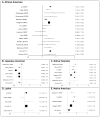Ethnic differences in breast cancer survival: status and determinants
- PMID: 22040209
- PMCID: PMC3256927
- DOI: 10.2217/whe.11.67
Ethnic differences in breast cancer survival: status and determinants
Abstract
Ethnic differences in breast cancer survival have been a long-standing concern. The objective of this article is to present relevant studies for all major US racial/ethnic groups including African-Americans, Latinos, Native Americans, Japanese-Americans and Native Hawaiians, and to discuss underlying causes of disparity. In comparison to Caucasian women, African-American women continue to experience the poorest breast cancer-specific survival of all ethnic groups in the USA. The prognosis for Latinos, Native Hawaiians and Native Americans is intermediate, better than for African-Americans but not as good as for Caucasians, whereas Japanese-American women tend to have better outcomes. The following possible contributors to the observed differences are discussed in detail: unfavorable distribution of stage at diagnosis due to low screening rates, limited access to care and treatment, tumor type, comorbidities, socioeconomic status, obesity and physical activity.
Conflict of interest statement
The authors declare that they have no conflict of interest.
Figures

References
-
- Howlader N, Noone A, Krapcho M, et al. SEER Cancer Statistics Review, 1975–2008. National Cancer Institute; Bethesda, MD, USA: 2011. Provides recent breast cancer incidence, mortality, and survival data for cancer registries in the US.
-
- Harper S, Lynch J, Meersman SC, Breen N, Davis WW, Reichman MC. Trends in area-socioeconomic and race-ethnic disparities in breast cancer incidence, stage at diagnosis, screening, mortality, and survival among women ages 50 years and over (1987–2005) Cancer Epidemiol Biomarkers Prev. 2009;18(1):121–131. - PubMed
-
- Smigal C, Jemal A, Ward E, et al. Trends in breast cancer by race and ethnicity: update 2006. CA Cancer J Clin. 2006;56(3):168–183. - PubMed
-
- Newman LA, Griffith KA, Jatoi I, Simon MS, Crowe JP, Colditz GA. Meta-analysis of survival in African American and white American patients with breast cancer: ethnicity compared with socioeconomic status. J Clin Oncol. 2006;24(9):1342–1349. Large analyses of 20 different studies that included African American women and adjusted for SES. - PubMed
-
- LeMarchand L, Kolonel LN, Nomura AM. Relationship of ethnicity and other prognostic factors to breast cancer survival patterns in Hawaii. J Natl Cancer Inst. 1984;73(6):1259–1265. - PubMed
Publication types
MeSH terms
Grants and funding
LinkOut - more resources
Full Text Sources
Medical

